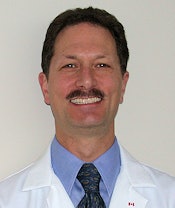
SAN FRANCISCO - Are you still reading CT images off your PACS without hanging protocols? If so, that's like going through your email inbox without a spam filter, according to Dr. Jeffrey Mendel, who offered six tips for designing time-saving hanging protocols in a talk at the 2015 International Symposium on Multidetector-Row CT (MDCT).
It's easy to see why many radiologists avoid taking the time to set up good hanging protocols in their PACS software, said Mendel, who is an assistant professor of radiology at Tufts University and a senior health and policy adviser at Partners in Health, a Boston-based nonprofit organization.
 Dr. Jeffrey Mendel from Partners in Health.
Dr. Jeffrey Mendel from Partners in Health.For one thing, many radiologists may be using poorly designed PACS software that doesn't support hanging protocols. Others may have received little training on their facility's network, such as a radiologist who joined an institution after the PACS was installed and was trained by other radiologists, for example.
Some radiologists may not receive adequate support from PACS administrators, while others simply may not want to take the time to develop protocols, instead putting it off until later.
But the short-term pain it takes to develop good hanging protocols yields long-term gain with respect to time savings down the road, Mendel told MDCT 2015 attendees. A number of tools are available that can help, and a particularly efficient strategy is simply to copy good hanging protocols that a fellow radiologist might be using.
"It's likely that one of your colleagues has really good hanging protocols," Mendel said. "Get your PACS administrator to copy them over and start from there -- it's much easier than creating them yourself."
Starting from scratch
But if you do have to start from scratch, Mendel offered a number of valuable pointers. For one, radiologists should educate themselves a bit on the basic concepts of visual acuity. For example, at the typical viewing distance from a PACS monitor, humans have an adequate macular vision range that is about 5 cm in diameter. That means that when viewing a large image such as a chest x-ray, radiologists need to scan back and forth to take in the whole image.
Also, design your protocols to avoid being forced to manually zoom in on images at all costs, Mendel said. Images should fill the screen without the radiologist having to zoom. Parameters that could be saved into hanging protocols include window/level, zoom/pan, linking between similar studies, multiplanar reformats (MPRs), orientation correction, and syncing so that images are the same size between different studies.
It's also important to coordinate with radiologic technologists so that their CT acquisition protocols match the hanging protocols radiologists are using. For example, field-of-view should be matched to the size of the body part to maximize the available hanging space, and patient movement should be minimized between sequential acquisitions. Technologists can also develop a simple hanging protocol that they can use for protocoling CT scans.
Mendel recommends the use of multiple-stage hanging protocols, which he believes should be supported by most PACS software applications in this day and age. You're in better shape if your PACS already has support for intuitive creation and modification of hanging protocols, he believes; if not, you should create a smaller number of general protocols that will work most of the time. Body region and modality can be used to select protocols rather than specific study descriptors.
Once you're ready to start creating your own hanging protocols, Mendel recommends designing them to cover six stages of the image interpretation process:
- Start with scout images. It's known that scout images occasionally show significant pathology, so ignoring them could have both clinical and medicolegal consequences. Design a stage in your hanging protocol that has a current scout image with a couple of old radiographs for comparison; it will give you a quick snapshot of the clinical course of the patient.
- Use the appropriate-sized viewport. While the viewport for digital radiography (DR) images might need to be large due to the modality's large image matrix, CT images are smaller and are scrolled through while the eye is relatively fixed on one position. Make sure the image you're reviewing fills up most of your macular vision area to avoid eye strain.
- Know your weak points, and design hanging protocols to counter them. For example, it's well-known that radiologists don't look as thoroughly at the base of the lung on abdominal CT scans. So build into your hanging protocols a viewport that has axial and coronal images on a lung window, and make a viewport that has sagittal images on a bone window so fractures won't be missed.
- Use the ability of your PACS to find relevant prior studies. Radiologists have a good idea of the prior images they would like to see for any given case, so create a stage in your protocols that will display six, nine, or even 12 prior images on your left-hand monitor.
- Support annotated images. Radiologists are often interrupted in the course of reading a study, and this can make it hard to get back to where they left off. To counter this, create a final stage in your protocol with one viewport with key images that are linked to the axial series; this makes it easy to check the completeness of your reports. You can also create a stage with current and prior key images that are linked to their respective axial series.
- Don't forget about unviewed image series. This is becoming more of an issue with increasingly complex CT technologies, such as spectral CT and dual-energy imaging. If your PACS has the ability, develop a separate stage in your protocol to look at these series.
Developing hanging protocols can seem like a hassle at first, but not doing so means your practice isn't taking advantage of the efficiency tools that are transforming the way radiologists work, Mendel concluded.
"The first rule of any technology used in business is that automation applied to an efficient operation will magnify the efficiency," he said. "Try to make sure you are using your protocols in that way."



















